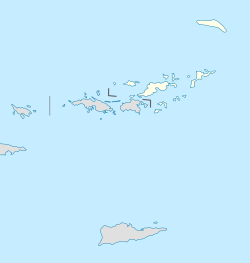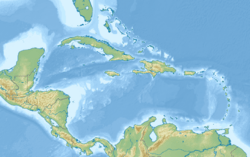Virgin Gorda facts for kids

Overlooking the North Sound, 2010
|
|
|
The location of Virgin Gorda within the British Virgin Islands
|
|
| Geography | |
|---|---|
| Location | Atlantic Ocean |
| Coordinates | 18°28′55″N 64°23′25″W / 18.48194°N 64.39028°W |
| Archipelago | Virgin Islands |
| Administration | |
|
United Kingdom
|
|
| British Overseas Territory | British Virgin Islands |
| Demographics | |
| Population | 3,930 (2010) |
| Additional information | |
| Time zone | |
| ISO code | VG |
Virgin Gorda is the third-largest (after Tortola and Anegada) and second-most populous of the British Virgin Islands (BVI).
Contents
Geography
Located at about 18 degrees, 48 minutes North, and 64 degrees, 30 minutes West, it covers an area of about 8 square miles (21 km2).
The main commercial and residential area is Spanish Town on the southwestern part of the island.
An unusual geologic formation known as "the Baths" located on the southern end of the island makes Virgin Gorda one of the BVI's major tourist destinations. At the Baths, in spite of evidence of the island's largely volcanic origins, huge granite boulders lie in piles on the beach, forming scenic grottoes that are open to the sea. Granite is an intrusive igneous rock, thus not volcanic. It did form from magma, however, at great depth. Granite becomes exposed at surface only after geologic ages of erosion removes the overburden. Further erosion broke the granite into large boulders and rounded their surfaces. North of the Baths is the Virgin Gorda Yacht Harbor, formerly owned by Little Dix Bay. The most notable ruin on Virgin Gorda is the old Copper Mine.
One of the great harbors of the world, North Sound, and historically Gorda Sound, lies at the northeast end of the island. It is bordered by four islands and connecting reef systems that keep the sound calm, creating one of the world's great watersports meccas, with over 3,000 acres (1,200 ha) of protected waters. At the eastern end of the sound is the premier anchorage, in the lee of Biras Hill (elevation 435 ft (133 m)). The village, resort, and marina at this point (Jon'O'Point) is called the Bitter End Yacht Club, and runs for about a mile of coastline.
History
Christopher Columbus is said to have named the island "the Fat Virgin", because the island's profile on the horizon looks like a fat woman lying on her side.
Historically renowned, the anchorage off Bitter End was the site of Sir Francis Drake and Sir John Hawkins' 1595 fleet rendezvous, two Elizabethan British admirals who led Britain's ascendance into naval supremacy. Twenty-six ships anchored in the sound and used the large hill at Bitter End to practice for their attack on San Juan, to wrest Puerto Rico from Spain. With both admirals dying on the 1595/1596 voyage, the land at Bitter End may be the last place that these legendary mariners set foot on British soil.
Transportation
Ferry services from Virgin Gorda, Tortola, St. Thomas, and St. John, as well as small airlines, serve the island. In January 2010, Virgin Gorda Airport was restricted to a very small list of airlines by Air Safety Support International, the territory's aviation regulatory agency, which demanded that the airport be brought in line with international safety standards. The airport reopened in December 2010.
Tourists come from neighboring islands such as Tortola and St. Thomas by boat and return to these islands for air transportation.
Education
The BVI operates several government schools. Virgin Gorda residents are served by Robinson O'Neal Memorial Primary School and Bregado Flax Educational Centre, a combined primary and secondary school that opened in 1982. In 2000 the government created plans to create a primary school on the island.
See also
 In Spanish: Virgen Gorda para niños
In Spanish: Virgen Gorda para niños





